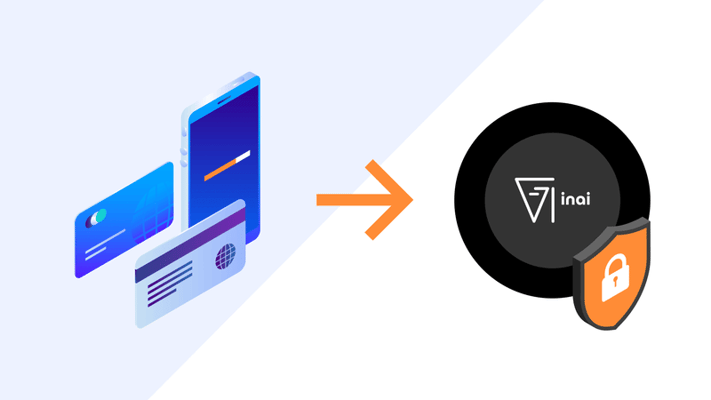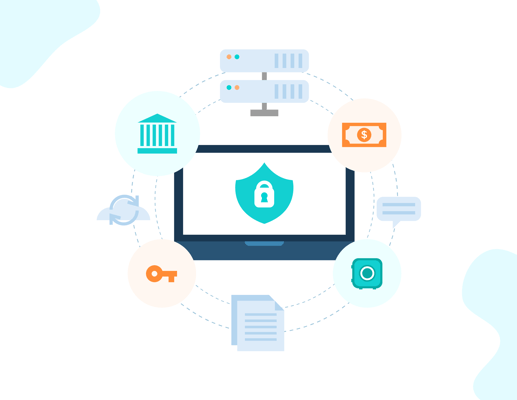With the ever-increasing online data thefts and payment fraud, tokenization has emerged as one of the most secure methods to store and process confidential customer card information. However, there's more to it than just added security. In fact, tokenization offers a slew of benefits that can enhance your payment stack. Want to know more? Keep reading.
Let's dive deep into what tokenization is, the role it plays in safeguarding sensitive card data, and the benefits it brings to your payment ecosystem. Trust us; this knowledge will be a game-changer.
What is Tokenization?
Tokenization in payments is when sensitive information, such as the card number, is replaced with randomly generated numbers called tokens. These tokens securely hold all the confidential data and protect it against data breaches, cyber-attacks, and other frauds.
What Are the Types of Tokenization?
Payment tokenization is basically of two types:
1. Vault Tokenization
Vault tokenization involves a tokenization database or vault wherein the sensitive payment data is stored along with the corresponding non-sensitive data. So, a record will be added to the tokenization vault for every tokenized payment.
The respective parties, such as the payment processors, can then use the database to detokenize the data as and when required. Detokenization is converting non-sensitive or tokenized information to original and sensitive information.
However, there's a downside to vault tokenization. The data is stored in a database which will grow as more customers tokenize their information. And this will increase the time required to detokenize the data, making the process less responsive.
2. Vaultless Tokenization
Vaultless tokenization, on the other hand, caters to the disadvantage that vault tokenization brings. In vaultless tokenization, the token is created via a mathematical algorithm. The data can be detokenized using the same token without looking for the original data in the vault. This way, detokenization will always be instant no matter how many tokens are generated.
How Does Tokenization Work and What Are Its Benefits?
Here's how a tokenized card transaction work:
-
Payment Details are Entered
The customer enters the payment details and initiates the transaction. If it's offline, a POS device is used; otherwise, the customer inputs the card information directly on the merchant's website.
-
Token is Generated
After the customer enters the information, the checkout platform creates a "token," which is a series of random numbers and alphabets. For instance, if the card number entered was "1235 4589 8486 020", a token would look something like HFDNSD45654.
-
The Token is Sent to the Payment Processor
The token generated in the previous step will then be encrypted and sent to the payment processor. Also, the payment information will be safely stored with the payment gateway, which can later be used to validate the token against the original data.
During this process, additional payment information, such as the wallet used in the transaction, is attached to the token.
-
The Token Is Encrypted and Sent to the ACH Network
Once the payment processor receives the encrypted token, the information is again encrypted and sent to the ACH network for validation.
-
Authorization and Notification
If everything goes as expected and the payment is authorized, the confirmation message is sent to all the involved parties, including the processor, the customer, and the merchant. While this process seems lengthy, it happens within seconds and adds to the customer's convenience.
Now that you know how tokenization works, let's learn about some benefits it offers:
-
Security:
Tokenization helps make transactions more secure, which benefits both the customers and the merchant. As a merchant, you can uphold your business reputation, and as a customer, you can trust a business more if they're using tokenization.
-
Convenience:
With tokenization in place, you can remove unnecessary security measures and process refunds faster, adding to your convenience. Moreover, repeat customers can make quick purchases without having to reenter payment information, which ensures a better customer experience.
-
Speed:
Tokenization happens within a matter of seconds. And speed is essential for a good customer experience.
5 Reasons Why You Must Use Payment Tokenization
.png?width=2500&height=3008&name=Infographic%20-%201%20(4).png)
-
Reduce your PCI Scope
All the merchants who store/process customer cardholder data must comply with various PCI regulations. And complying with these regulations is quite a cumbersome process, requiring dedicated resources and effort.
However, you can largely reduce your PCI scope using tokenization. How? The Payment Card Industry Data Security Standard or PCI DSS doesn't consider tokenized data as cardholder information, as it cannot be used to retrieve sensitive information. So, technically, you're not processing any sensitive information.
Instead of you (merchant), the majority burden of PCI compliance requirements shifts to the token provider, reducing your overall PCI scope. So, you can easily route tokens through your environment without spending resources and time on additional PCI requirements and save yourself a lot of hassle.
-
Lower your Cost
Reducing your PCI scope makes compliance easier, less resource-intensive, and more affordable because you don't need as many auditors to verify compliance or perform as many audits had there been no tokenization.
Also, when you don't have any customer card information on your network, you automatically reduce the risk of a data breach. This way, you don't have to invest much in software solutions for fraud prevention. And this, again, helps lower your costs.
-
Better Security and a Streamlined Shopping Experience
One of the most obvious benefits of tokenization is better security. When the card information is tokenized, the likeliness of data breaches and fraud reduces substantially. Even if the tokenized information is leaked, it cannot be misused, further reducing fraud.
In addition to enhancing security, tokenization helps improve the customer shopping experience. How? When customers enter their card information, merchants can tokenize and save the information on file. This way, when repeat buyers make a new purchase, they don't have to enter payment information again, ensuring a seamless and faster shipping experience.
-
Helping you Keep your Cards on File Up-To-Date
Merchants, especially in the subscription domain, store customer card information on file for a long time. However, the card information can become invalid in case the card expires or is simply blocked due to fraud. And this can lead to transaction decline, which further costs merchants, money, and customers, a poor shopping experience.
However, you can tackle this issue by tokenizing the card information and integrating an automated account updater. An automated account updater will use the token and update the card information on file without your involvement. This way, you can ensure up-to-date information, fewer declines, and a better customer experience.
-
Facilitating an Omnichannel Payment Strategy
An omnichannel payment strategy is essential when you target customers from all channels, including stores, social media, mobile apps, and website. And that's something you can make possible with tokenization.
Using tokenization, you can identify customers across all channels and offer them a seamless omnichannel payment experience.
For instance, if a customer makes a payment using their card via a POS terminal with an omnichannel payment strategy, they can make an online purchase without entering the payment information again. Customers can approach your business from any channel and enjoy the same overall experience.
What Is the Difference Between Payment Tokenization and Encryption?
While payment tokenization and encryption share the same goal: to safeguard confidential payment information, they do so in different ways.
For instance, tokenization, as stated earlier, replaces sensitive data with non-sensitive tokens.
Encryption, on the other hand, is a cryptography technique that converts every piece of sensitive information into unreadable data. The sensitive information is modified mathematically using an encryption algorithm. So, there's a mathematical relation between the original and encrypted data.
One significant difference between tokenization and encryption is that encryption is reversible. You can decipher the encrypted information using a key and reveal the original sensitive information. Also, hackers can decrypt the information if they have the key, making it insecure.
However, once tokenized, you can only decipher the data if an original data source is present. So, in case the tokenized information is stolen, the hackers won't be able to access the original data. And this makes tokenization more secure than encryption.
Examples of Payment Tokenization
%20(1).png?width=2500&height=2043&name=Infographic%20-%202%20(4)%20(1).png)
-
One-Click Payment
The customers' payment information is stored when they purchase with an online or offline store. And when the same customers revisit the store or its website, they can complete the purchase with a single click without having to enter all the information again.
-
Mobile Wallets
Mobile wallets such as Google Pay, Samsung Pay, and Apple Pay use tokenization for processing secure transactions. When the customer chooses wallet as the payment mode, the respective wallet sends the data to the card network. The data is then replaced with a unique token sent to the wallet, ready to be used for upcoming transactions.
-
Recurring Payments
Subscription-based businesses use recurring payments to charge their customers regularly for services. However, such transactions can be risky for the merchants, as recurring payment fraud is common.
Tokenization allows merchants to secure and process recurring payments seamlessly and automatically update customer data without much effort. This way, merchants can protect the customer and their payment information while ensuring regular payments.
-
Contactless Transactions
Contactless payments at stores or petrol stations also use tokenization in the background. The customer can wave their card over the machine, and the transaction securely goes through.
Wrapping Up
By implementing tokenization, your business can combat fraudulent activity, simplify PCI compliance requirements, enhance the overall shopping experience, streamline the use of saved payment cards, and establish a seamless omnichannel payment system.
Take advantage of these important benefits! Enabling tokenization should be a top priority to help elevate your payment stack and propel your business to greater success.
.png?width=123&height=71&name=inai%20logo%20-%20dark%201(1).png)
.png)
.png?width=4068&height=1080&name=CTA%20(13).png)
.png?width=150&name=karthik%20(1).png)

.png?width=50&name=karthik%20(1).png)


.png?height=400&name=Header%20-%20How%20Can%20Payment%20Orchestration%20Help%20Merchants%20with%20Fraud%20Prevention_%20(1).png)
.jpg?width=50&name=IMG_5672%20(1).jpg)